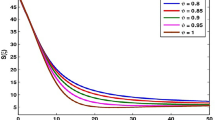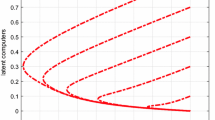Abstract
In this work, we consider a fractional-order epidemiological model for computer viruses to study memory effects on population dynamics. This model is derived from a well-known integer-order epidemiological model and the Caputo fractional derivative. Our objective is to provide a rigorous mathematical analysis for dynamics of the fractional-order model. Here, positivity, linear invariant, asymptotic stability properties including local and global asymptotic stability, uniform and Mittag-Leffler stability are established. It is worth noting that the stability properties are investigated by a simple approach, which is based on stability theory for fractional-order dynamical systems and an appropriate linear Lyapunov function. As an important consequence, dynamical properties of the fractional-order model are determined fully. Additionally, a set of numerical experiments is conducted to support the theoretical findings. As we expect, the numerical results are consistent with the theoretical ones.









Similar content being viewed by others
Availability of data and materials
The data that support the fndings of this study are available within the article.
Code availability
Not applicable.
References
Agarwal, R.P., O’Regan, D., Hristova, S.: Stability of Caputo fractional differential equations by Lyapunov functions. Appl. Math. 60, 653–676 (2015)
Aguila-Camacho, N., Duarte-Mermoud, A.M., Gallegos, J.A.: Lyapunov functions for fractional order systems. Commun. Nonlinear Sci. Numer. Simul. 19, 2951–2957 (2014)
Almeida, R.: Analysis of a fractional SEIR model with treatment. Appl. Math. Lett. 84, 56–62 (2018)
Baleanu, D., Machado, J.A.T., Luo, A.C.J.: Fractional Dynamics and Control. Springer, New York (2012)
Baleanu, D., Diethelm, K., Scalas, E., Trujillo, J.J.: Fractional Calculus: Models and Numerical Methods. World Scientific, Singapore (2021)
Baleanu, D., Agarwal, R.V.: Fractional calculus in the sky. Adv. Differ. Equ. 117 (2021)
Bonyah, E., Atangana, A., Khan, M.A.: Modeling the spread of computer virus via Caputo fractional and the beta-derivative. Asia Pacific J. Comput. Eng. 4, 1 (2017)
Caputo, M.: Linear models of dissipation whose Q is almost frequency independent-II. Geophys. J. Int. 13, 529–539 (1967)
Cohen, F.: Computer virus: theory and experiments. Comput. Security 6, 22–35 (1987)
Dang, Q.A., Hoang, M.T.: Positivity and global stability preserving NSFD schemes for a mixing propagation model of computer viruses. J. Comput. Appl. Math. 374, 112753 (2020)
Dang, Q.A., Hoang, M.T.: Numerical dynamics of nonstandard finite difference schemes for a computer virus propagation model, International Journal of. Dyn. Control 8, 772–778 (2020)
Dang, Q.A., Hoang, M.T., Dang, Q.L.: Nonstandard finite difference schemes for solving a modified epidemiological model for computer viruses. J. Comput. Sci. Cybernet. 32, 171–185 (2018)
Diethelm, K.: The Analysis of Fractional Differential Equations: An Application-Oriented Exposition Using Differential Operators of Caputo Type. Springer-Verlag, Berlin (2010)
Diethelm, K.: Monotonicity of functions and sign changes of their Caputo derivatives. Fraction. Calculus Appl. Anal. 19, 561–566 (2016). https://doi.org/10.1515/fca-2016-0029
Diethelm, K.: A fractional calculus based model for the simulation of an outbreak of dengue fever. Nonlinear Dyn. 71, 613–619 (2013)
Dokuyucu, M.A., Dutta, H., Yildirim, C.: Application of non-local and non-singular kernel to an epidemiological model with fractional order. Math. Methods Appl. Sci. 44, 3468–3484 (2021)
Duarte-Mermoud, M.A., Aguila-Camacho, N., Gallegos, A.J., Castro-Linares, R.: Using general quadratic Lyapunov functions to prove Lyapunov uniform stability for fractional order systems. Commun. Nonlinear Sci. Numer. Simul. 22, 650–659 (2015)
Freihat, A.A., Zurigat, M., Handam, A.H.: The multi-step homotopy analysis method for modified epidemiological model for computer viruses. Afrika Matematika 26, 585–596 (2015)
Gan, C., Yang, X., Zhu, Q., Jin, J., He, L.: The spread of computer virus under the effect of external computers. Nonlinear Dyn. 73, 1615–1620 (2013)
Gan, C., Yang, X., Liu, W., Zhu, Q., Zhang, X.: An epidemic model of computer viruses with vaccination and generalized nonlinear incidence rate. Appl. Math. Comput. 222, 265–274 (2013)
Gan, C., Yang, X., Liu, W., Zhu, Q.: A propagation model of computer virus with nonlinear vaccination probability. Commun. Nonlinear Sci. Numer. Simul. 19, 92–100 (2014)
Ghosh, U., Pal, S., Banerjee, M.: Memory effect on Bazykin’s prey-predator model: Stability and bifurcation analysis. Chaos Solitons Fractals 143, 110531 (2021)
Hoang, M.T.: Lyapunov Functions for Investigating Stability Properties of a Fractional-Order Computer Virus Propagation Model. Qualit. Theory Dyn. Syst. 20, 74 (2021)
Hoang, M.T., Nagy, A.M.: Uniform asymptotic stability of a Logistic model with feedback control of fractional order and nonstandard finite difference schemes. Chaos Solitons Fractals 123, 24–34 (2019)
Hu, Z., Wang, H., Liao, F., Ma, W.: Stability analysis of a computer virus model in latent period. Chaos Solitons Fractals 75, 20–28 (2015)
Kephart, J.O., White, S.R., Chess, D.M.: Computers and epidemiology. IEEE Spectrum 30, 20–26 (1993)
Khalil, H.K.: Nonlinear Systems, 3rd edn. Prentice Hall, London (2002)
Kheiri, H., Jafari, M.: Stability analysis of a fractional order model for the HIV/AIDS epidemic in a patchy environment. J. Comput. Appl. Math. 346, 323–339 (2019)
Kilbas, A.A., Srivastava, H.M., Trujillo, J.J.: Theory and Applications of Fractional Differential Equations, vol. 204, 1st edn. Elsevier Science Inc., New York (2006)
LaSalle, J.P.: The Stability of Dynamical Systems. SIAM, Philadelphia (1976)
Li, C., Zeng, F.: Finite difference methods for fractional differential equations. Int. J. Bifurc. Chaos 22, 1230014 (2012)
Li, C., Zeng, F.: The finite difference methods for fractional ordinary differential equations. Numer. Funct. Anal. Opt. 34(2), 149–179 (2013)
Li, C., Ma, Y.: Fractional dynamical system and its linearization theorem. Nonlinear Dyn. 71, 621–633 (2013)
Li, Y., Chen, Y., Podlubny, I.: Stability of fractional-order nonlinear dynamic systems: Lyapunov direct method and generalized Mittag-Leffler stability. Comput. Math. Appl. 59, 1810–1821 (2010)
Lin, W.: Global existence theory and chaos control of fractional differential equations. J. Math. Anal. Appl. 332, 709–726 (2007)
Lyapunov, A.M.: The general problem of the stability of motion. Int. J. Control 55, 531–534 (1992)
Matignon, D.: Stability result on fractional differential equations with applications to control processing. Computat. Eng. Syst. Appl. 2, 963–968 (1996)
Murray, W.: The application of epidemiology to computer viruses. Comput. Security 7, 139–150 (1988)
Odibat, Z.M., Shawagfeh, N.T.: Generalized Taylor’s formula. Appl. Math. Comput. 186, 286–293 (2007)
Piqueira, J.R.C., de Vasconcelos, A.A., Gabriel, C.E.C.J., Araujo, V.O.: Dynamic models for computer viruses. Comput. Security 27, 355–359 (2008)
Piqueira, J.R.C., Araujo, V.O.: A modified epidemiological model for computer viruses. Appl. Math. Comput. 213, 355–360 (2009)
Piqueira, J.R.C., Batistela, C.M.: Considering quarantine in the SIRA malware propagation model. Math. Prob. Eng. 2019, 6467104 (2019). https://doi.org/10.1155/2019/6467104
Podlubny, I.: Fractional Differential Equations. Academic Press, San Diego (1999)
Ren, J., Xu, Y.: A compartmental model for computer virus propagation with kill signals. Phys. A 486, 446–454 (2017)
Scherer, R., Kalla, S.L., Tang, Y., Huang, J.: The Grunwald-Letnikov method for fractional differential equations. Comput. Math. Appl. 62, 902–917 (2011)
Singh, J., Kumar, D., Hammouch, Z., Atangana, A.: A fractional epidemiological model for computer viruses pertaining to a new fractional derivative. Appl. Math. Comput. 316, 504–515 (2018)
Sun, H.G., Zhang, Y., Baleanu, D., Chen, W., Chen, Y.Q.: A new collection of real world applications of fractional calculus in science and engineering. Commun. Nonlinear Sci. Numer. Simul. 64, 213–231 (2018)
Wang, F., Yang, Y.: Fractional order Barbalat’s lemma and its applications in the stability of fractional order nonlinear systems. Math. Modell. Anal. 22, 503–513 (2017)
Yang, L.-X., Yang, X., Zhua, Q., Wen, L.: A computer virus model with graded cure rates. Nonlinear Anal. Real World Appl. 14, 414–422 (2013)
Yang, L.-X., Yang, X.: A new epidemic model of computer viruses. Commun. Nonlinear Sci. Numer. Simul. 19, 1935–1944 (2014)
Zhu, Q., Yang, X., Yang, L.-X., Zhang, X.: A mixing propagation model of computer viruses and countermeasures. Nonlinear Dyn. 73, 1433–1441 (2013)
Acknowledgements
We would like to thank the editor and anonymous referees for useful and valuable comments that led to a great improvement of the paper.
Funding
Not applicable.
Author information
Authors and Affiliations
Corresponding author
Ethics declarations
Conflict of interest
The author declare that they have no conflict of interest regarding the publication of this article.
Ethical standard
The author state that this research complies with ethical standards. This research does not involve either human participants or animals.
Additional information
Communicated by José Alberto Cuminato.
Publisher's Note
Springer Nature remains neutral with regard to jurisdictional claims in published maps and institutional affiliations.
Rights and permissions
Springer Nature or its licensor (e.g. a society or other partner) holds exclusive rights to this article under a publishing agreement with the author(s) or other rightsholder(s); author self-archiving of the accepted manuscript version of this article is solely governed by the terms of such publishing agreement and applicable law.
About this article
Cite this article
Hoang, M.T. Dynamics of a fractional-order epidemiological model for computer viruses. São Paulo J. Math. Sci. (2023). https://doi.org/10.1007/s40863-023-00382-8
Accepted:
Published:
DOI: https://doi.org/10.1007/s40863-023-00382-8
Keywords
- Global dynamics
- Fractional differential equations
- Caputo fractional derivative
- Epidemiological models
- Computer viruses




